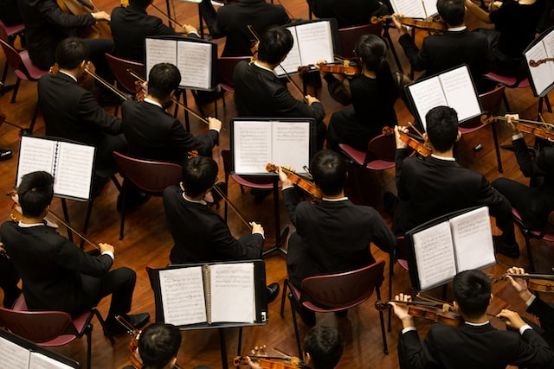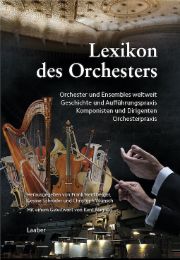On all matters concerning the orchestra
Orchestras and ensembles worldwide, history and performance practice, composers and conductors as well as orchestral practice - the "Dictionary of the Orchestra" provides information on all these topics.

It is actually a wonderful idea to dedicate a comprehensive encyclopaedia to the orchestra. The Laaber publishing house, which took on this challenge, decided to include articles about individual orchestras, countries, conductors, instruments and specialist topics (e.g. employment contract, general music director, rental material, audition or baton), as well as articles about composers who have written for orchestras. The articles were written by well over 200 contributors. Due to the wide variety of topics, there are around 1500 pages spread over two heavyweight volumes. Unfortunately, the quality of the contributions varies greatly.
If you study the composer biographies a little more closely, you will find passages that are not convincing. The author of the article on Charles Koechlin, for example, writes that his love of Alsatian folk music characterized his music, but this is not true. Several of Koechlin's work titles are misspelled, but one work is also mentioned (Les temples), which does not even exist. Rather incomprehensible is the observation: "In his orchestral works, Koechlin frequently uses contrapuntal procedures, even going as far as counterpoint with complex chordal structures."
Other articles contain truisms such as "Moreover, he consciously gives each of his pieces its very own face" (Peter Eötvös) or debatable conclusions such as "Suk's compositional legacy Epilogue on the other hand, is particularly impressive in terms of its consistently modernist tonal language, which at the same time contradicts normative ideas of late works" (Josef Suk). It remains to be seen whether the statement "Profane topoi often obscure the separation of artificial and functional music in Schreker and suggest new scenic contexts" in the article on Franz Schreker really helps.
It is understandable that the pieces in the catalogs of works are often selected very subjectively, but the fact that no works after 2014 are mentioned for Peter Eötvös, Kaija Saariaho, Georg Friedrich Haas or Erkki-Sven Tüür, for example, does not exactly make the encyclopedia up-to-date.
Of course, the encyclopedia contains many conductor biographies. But how can it be explained that there are no detailed biographies of three of the most important Czech conductors, namely Václav Talich, Karel Ančerl and Václav Smetáček? Part of the text on Teodor Currentzis, with its effusive praise, could have been taken from an advertising brochure: "Without a baton, with original, eruptive gestures, Currentzis demands unconditional devotion to the seriousness and truth of the music without regard for traditions and listening habits."
There is particular excitement in a Lexicon of the orchestra to the articles about the individual orchestras and orchestral culture in different countries. There is, of course, a wealth of information here, especially with regard to German orchestras. However, an unnecessary number of names are misspelled (examples: Frank von Hoesslin instead of Franz von Hoesslin, Toshiyuki Kamioki instead of Kamioka, both former GMD in Wuppertal). The fact that the Czech conductor Jiří Bělohlávek died in 2017 should be mentioned in an encyclopaedia published in 2021, as should the fact that the Dresden Philharmonic Orchestra has been performing in a new concert hall within the Dresden Kulturpalast since 2017. The details in the orchestra articles are also not to be trusted. For example, it is claimed that Henze's Symphony No. 7a work commissioned by the Berliner Philharmoniker, was premiered by the RSO Stuttgart. Many changes of chief conductor at the end of the 2010s are also not mentioned in the corresponding orchestra articles, which rather diminishes the relevance of the encyclopedia.
If you are interested in Norwegian music and orchestral culture, you will be fobbed off with very unsatisfactory information. The important orchestras are Oslo Filharmonien with 69 members (in reality there are 108), the Norwegian Radio Orchestra, the Kristiansund Symphony Orchestra (an amateur orchestra founded in 1919) and the Norwegian National Opera Orchestra. Not mentioned are the equally important orchestras of Bergen, Stavanger, Trondheim, Tromsø/Bodø and Kristiansand (not to be confused with Kristiansund).
Switzerland, however, fares no better: only the Basel Chamber Orchestra (which existed until 1987), the Orchestre de la Suisse Romande and the Tonhalle Orchestra Zurich are described in detail. The information on the orchestras in the canton of Bern is particularly sparse - and also outdated or simply incorrect: "The Bern Symphony Orchestra has existed since 1877; in 2011, the orchestra and the Stadttheater Bern were merged into the Konzert Theater Bern Foundation. Mario Venzago has held the position of chief conductor since 2010. In 2012, the Sinfonie Biel Solothurn, founded in 1969, merged with the Orchester Theater Biel Solothurn to form the Sinfonie Orchester Biel Solothurn. Since the year of the merger, the orchestra has been conducted by Kaspar Zehnder."
Since some articles on specialist topics and instruments were also written by authors who have only superficially dealt with their topic, the Lexicon of the orchestra not convincing in some respects.
Encyclopedia of the orchestra. Orchestras and ensembles worldwide, history and performance practice, composers and conductors, orchestral practice, edited by Frank Heidlberger, Gesine Schröder and Christoph Wünsch, 2 vols. with a total of 1488 p., € 198.00 (until 31.12.2022), Laaber, Lilienthal 2021, ISBN 978-3-89007-551-8









